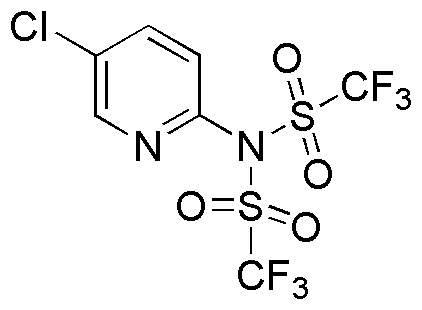N-(5-Chloro-2-pyridyl)bis(trifluoromethanesulfonimide) is widely utilized in research focused on:
- Organic Synthesis: This compound serves as a versatile reagent in organic chemistry, facilitating the formation of complex molecules through its strong electrophilic properties.
- Pharmaceutical Development: It is employed in the synthesis of various pharmaceuticals, particularly in creating compounds with enhanced biological activity and selectivity.
- Material Science: The chemical is used in developing advanced materials, including polymers and coatings, due to its thermal stability and resistance to chemical degradation.
- Agricultural Chemistry: It plays a role in the formulation of agrochemicals, helping to improve the efficacy of pesticides and herbicides while minimizing environmental impact.
- Electrochemistry: This compound is utilized in the development of ionic liquids and electrolytes, contributing to advancements in battery technology and energy storage solutions.
General Information
Properties
Safety and Regulations
Applications
N-(5-Chloro-2-pyridyl)bis(trifluoromethanesulfonimide) is widely utilized in research focused on:
- Organic Synthesis: This compound serves as a versatile reagent in organic chemistry, facilitating the formation of complex molecules through its strong electrophilic properties.
- Pharmaceutical Development: It is employed in the synthesis of various pharmaceuticals, particularly in creating compounds with enhanced biological activity and selectivity.
- Material Science: The chemical is used in developing advanced materials, including polymers and coatings, due to its thermal stability and resistance to chemical degradation.
- Agricultural Chemistry: It plays a role in the formulation of agrochemicals, helping to improve the efficacy of pesticides and herbicides while minimizing environmental impact.
- Electrochemistry: This compound is utilized in the development of ionic liquids and electrolytes, contributing to advancements in battery technology and energy storage solutions.
Documents
Safety Data Sheets (SDS)
The SDS provides comprehensive safety information on handling, storage, and disposal of the product.
Product Specification (PS)
The PS provides a comprehensive breakdown of the product’s properties, including chemical composition, physical state, purity, and storage requirements. It also details acceptable quality ranges and the product's intended applications.
Certificates of Analysis (COA)
Search for Certificates of Analysis (COA) by entering the products Lot Number. Lot and Batch Numbers can be found on a product’s label following the words ‘Lot’ or ‘Batch’.
*Catalog Number
*Lot Number
Certificates Of Origin (COO)
This COO confirms the country where the product was manufactured, and also details the materials and components used in it and whether it is derived from natural, synthetic, or other specific sources. This certificate may be required for customs, trade, and regulatory compliance.
*Catalog Number
*Lot Number
Safety Data Sheets (SDS)
The SDS provides comprehensive safety information on handling, storage, and disposal of the product.
DownloadProduct Specification (PS)
The PS provides a comprehensive breakdown of the product’s properties, including chemical composition, physical state, purity, and storage requirements. It also details acceptable quality ranges and the product's intended applications.
DownloadCertificates of Analysis (COA)
Search for Certificates of Analysis (COA) by entering the products Lot Number. Lot and Batch Numbers can be found on a product’s label following the words ‘Lot’ or ‘Batch’.
*Catalog Number
*Lot Number
Certificates Of Origin (COO)
This COO confirms the country where the product was manufactured, and also details the materials and components used in it and whether it is derived from natural, synthetic, or other specific sources. This certificate may be required for customs, trade, and regulatory compliance.


